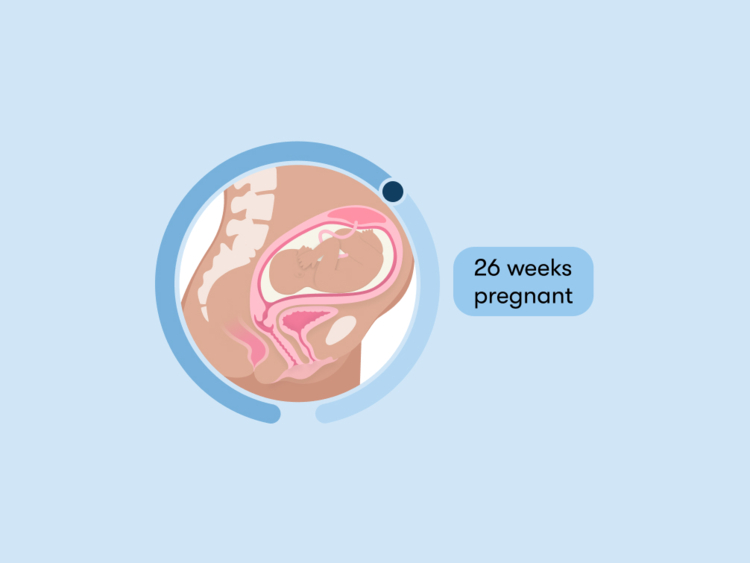During the 26th week of pregnancy, ensure good posture and practice foot and ankle exercises to relieve leg cramps. Entering the 26th week of pregnancy is a significant milestone, and as your body continues to change, it’s crucial to stay informed about potential symptoms and necessary precautions.
At this stage, maintaining good posture is essential. Additionally, addressing leg cramps by performing foot and ankle exercises can help alleviate discomfort. As you progress through the third trimester, taking proactive steps to prioritize your well-being and the health of your growing baby is vital.
Stay tuned for valuable tips and do’s and don’ts to navigate the remainder of your pregnancy journey with confidence and knowledge.
:max_bytes(150000):strip_icc()/tips-for-supporting-your-babys-brain-development-4707581-final-3f0ce122a6ea4370875d518c76e3238b.png)
Credit: www.verywellfamily.com
Table of Contents
ToggleUnderstanding The 26th Week Of Pregnancy
The 26th week of pregnancy is a crucial time as you near the end of the
second trimester. At this stage, it’s essential to be aware of your
baby’s development and the common symptoms you may experience. Read on to
learn more about what to expect during this significant phase of
pregnancy.
Baby’s Development At 26 Weeks
At 26 weeks, your baby’s development is marked by remarkable
growth and maturation. By this time, the baby is approximately the size of
a cucumber, measuring around 14 inches and weighing about 1.7 pounds. The
baby’s senses continue to develop, with the ability to perceive light,
sound, and touch. Additionally, the lungs are maturing, and the baby’s
kicks and movements become more noticeable as the nervous system
strengthens. It’s an extraordinary time as your baby’s tiny body prepares
for the journey into the world.
Common Symptoms In The 26th Week
As you progress through the 26th week of pregnancy, you may
experience a new set of symptoms. From increased leg cramps, especially
at night, to the prominence of heartburn and difficulty sleeping,
these can be common discomforts during this stage. Additionally, the
expanding uterus may lead to backaches and mild shortness of breath due to
pressure on the diaphragm. It’s important to stay mindful of these
symptoms and consider gentle exercises and relaxation techniques to ease
any discomfort.

Credit: www.thebump.com
Importance Of Nutrition
In the 26th week of pregnancy, nutrition plays a crucial role in the health and development of the baby, as well as the well-being of the expectant mother. A well-balanced diet is essential for providing the necessary nutrients for the baby’s growth and ensuring that the mother remains healthy throughout the pregnancy.
Balanced Diet For Baby’s Growth
Ensuring a balanced diet is crucial for the optimal growth and development of the baby. A variety of nutrients, including protein, calcium, iron, folic acid, and healthy fats, are required to support the baby’s increasing needs. Incorporating a mix of fruits, vegetables, lean proteins, whole grains, and dairy products creates a well-rounded diet that benefits both the mother and the baby.
Essential Nutrients For Expecting Mothers
Expecting mothers should pay attention to essential nutrients such as folate, omega-3 fatty acids, vitamin D, and iron. These nutrients support the mother’s overall health, aid in the prevention of birth defects, help in the formation of the baby’s brain and eyes, and contribute to the mother’s energy levels and bone health. Including a diverse range of foods rich in these nutrients is integral to supporting the mother’s well-being during the 26th week of pregnancy and beyond.
Tips For A Healthy Baby Bump
During the 26th week of pregnancy, focus on staying hydrated and eating nutrient-rich foods for a healthy baby bump. Incorporate gentle exercises and practice good posture to alleviate discomfort and promote well-being. Consistent prenatal care and sufficient rest are crucial during this stage of pregnancy.
Exercises For Pregnancy
– Engage in prenatal yoga or swimming for low-impact workouts.
– Perform pelvic floor exercises to strengthen core muscles.
– Go for short walks daily to stay active and improve circulation.
Proper Posture Maintenance
– Sit with your back straight and shoulders back.
– Ensure your buttocks touch the back of the chair.
– Avoid crossing your legs to maintain proper alignment.
Maintain a healthy baby bump with regular exercise and mindful posture practices during the 26th week of pregnancy. Focus on gentle activities like prenatal yoga and walking to stay active without straining your body. Remember to sit with proper posture by keeping your back straight and shoulders back while avoiding habits like crossing your legs. These simple tips can contribute to a smoother pregnancy journey for both you and your baby.
Preparing For Labor And Delivery
As you approach the 26th week of your pregnancy, it’s important to start preparing for labor and delivery. This is an exciting time filled with anticipation and it’s essential to make sure you are well-prepared. With just a few months left until your due date, now is the perfect time to start thinking about your birth plan and packing your hospital bag.
Birth Plan Considerations
Creating a birth plan can help you communicate your preferences to your healthcare provider and ensure that your labor and delivery experience goes as smoothly as possible. While it’s important to be flexible, having a plan in place can provide you with a sense of control and help you make informed decisions during the process. Here are some things to consider when creating your birth plan:
- Decide on your preferred birthing location, whether it’s a hospital, birthing center, or home birth.
- Think about your pain management options, such as natural techniques, epidurals, or other medications.
- Consider who you want to be present during labor and delivery, whether it’s just your partner or other family members.
- Discuss any special requests or preferences with your healthcare provider, such as delayed cord clamping or immediate skin-to-skin contact with your baby.
Remember, your birth plan is a guide and things may not always go according to plan. Stay open-minded and trust that your healthcare provider has your best interests and the safety of you and your baby in mind.
Pack Your Hospital Bag
Having your hospital bag packed and ready to go is an essential part of preparing for labor and delivery. It’s best to have your bag packed and easily accessible by around 36 weeks, just in case your baby decides to make an early arrival. Here are some items you’ll want to include in your hospital bag:
- Comfortable clothing and slippers for labor and postpartum.
- Toiletries, such as toothbrush, toothpaste, shampoo, and conditioner.
- Nursing bras and breast pads if you plan to breastfeed.
- Snacks and drinks to keep you nourished during labor.
- Entertainment items, such as books, magazines, or a tablet.
- Phone and charger to keep in touch with loved ones.
- Going-home outfit for both you and your baby.
By preparing your birth plan and packing your hospital bag in advance, you’ll be better equipped to handle the upcoming labor and delivery. Remember to stay flexible, trust your healthcare provider, and most importantly, take care of yourself and your growing baby.
Staying Comfortable And Relaxed
As you enter the 26th week of pregnancy, it’s important to prioritize your comfort and relaxation. Managing discomfort in the third trimester becomes crucial, and practicing self-care is essential for expectant mothers. In this article, we’ll provide you with helpful tips on how to stay comfortable and relaxed during this stage of pregnancy.
Managing Discomfort In The Third Trimester
The third trimester can bring about new challenges as your baby continues to grow. Here are some strategies to help alleviate discomfort:
- Practice good posture: Maintaining good posture is crucial for reducing back pain and promoting comfort. Sit up with your back straight and shoulders back, and make sure your buttocks touches the back of your chair.
- Engage in gentle exercises: Perform foot and ankle exercises to relieve leg cramps. Simply pulling your toes upwards or massaging the affected muscles can provide relief.
- Use supportive pillows: Invest in body pillows or pregnancy pillows to support your growing belly and reduce pressure on your back. These pillows can provide additional comfort while sleeping or resting.
- Wear comfortable clothing: Opt for loose-fitting, breathable clothing to prevent discomfort and allow for better air circulation. Maternity-specific clothing can accommodate your changing body shape and provide added comfort.
Self-care Practices For Expectant Mothers
During the third trimester, taking care of yourself is vital. Here are some self-care practices to incorporate into your routine:
- Rest and relax: Make sure to prioritize relaxation. Take regular breaks throughout the day, practice deep breathing exercises, and indulge in activities that help you unwind, such as reading, listening to soothing music, or taking warm baths.
- Pamper yourself: Treat yourself to prenatal massages, pedicures, or facials to alleviate any physical discomfort and promote overall well-being. These services can help reduce swelling, improve circulation, and provide a soothing experience.
- Maintain a healthy diet: Focus on consuming nutritious foods that provide essential vitamins and minerals for both you and your baby. Stay hydrated, incorporate plenty of fruits and vegetables, and aim for a balanced diet that includes whole grains, lean proteins, and healthy fats.
- Stay active: Engage in gentle exercises such as prenatal yoga or swimming, which can help alleviate discomfort, improve flexibility, reduce stress, and promote better sleep.
By implementing these tips and prioritizing your comfort and relaxation, you can better navigate the third trimester of pregnancy and promote your overall well-being. Remember to listen to your body and reach out to healthcare professionals if you experience any significant discomfort or concerns.

Credit: www.thebump.com
Frequently Asked Questions On 26th Week Of Pregnancy Tips
What Is Interesting About Week 26 Of Pregnancy?
During week 26 of pregnancy, your baby’s senses are developing, and they can now hear sounds outside the womb. You may also experience sychronized kicking by the baby.
How Should I Sit At 26 Weeks Pregnant?
During pregnancy, sit with your back straight and shoulders back. Ensure your buttocks touch the chair. Consider doing foot and ankle exercises to alleviate leg cramps.
What Position Is Baby In At 26 Weeks?
At 26 weeks, the baby is likely in a head-down position preparing for birth.
How Should My Belly Look At 26 Weeks Pregnant?
At 26 weeks pregnant, your belly should be round and noticeable, showing the growth of your baby. It may also feel a bit cramped as your baby continues to develop. Remember to take care of yourself and follow your healthcare provider’s guidelines for a healthy pregnancy.
Conclusion
As you approach the 26th week of pregnancy, remember to prioritize self-care, maintain good posture, and be mindful of any discomfort. Stay hydrated, connect with your baby, and seek support when needed. Embrace this special journey with positivity and readiness for the weeks ahead.
Take care of yourself and your growing baby!

Mother of Two children. I’m a former teacher with a background in child development and a passion for Good parenting. I understand child development and know how to develop activities to help children learn and grow. Spare time, I enjoy spending time with my family, reading, and volunteering in my community. Read More








